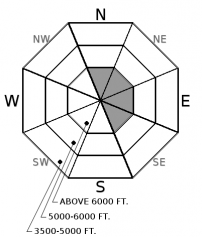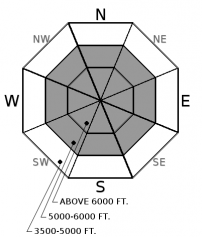| Monday | Monday Night | Tuesday | |
|---|---|---|---|
| Cloud Cover: | Snow developing with windy conditions | Light to moderate snow | Clearing and drying |
| Temperatures: | 25 to 30 deg. F. | 14 to 19 deg. F. | 26 to 31 deg. F. |
| Wind Direction: | SW | SW | SW |
| Wind Speed: | 6 to 16 mph gusting to 33 | 5 to 15 mph with gusts to 31 | 1 to 11 mph |
| Snowfall: | 1 to 3 in. | 1 to 3 in. | 0 in. |
| Snow Line: |
Swan Range
How to read the forecast
Moderate to strong southwest winds increased overnight forming slabs on top of crusts and low density snow at upper elevations. Continued windy conditions will thicken these slabs throughout the day. Several buried weak layers remain a concern and require evaluation before committing to consequential terrain. A human triggered avalanche remains possible and practicing safe travel techniques is recommended.

2. Moderate
?
Above 6500 ft.
2. Moderate
?
5000-6500 ft.
1. Low
?
3500-5000 ft.
- 1. Low
- 2. Moderate
- 3. Considerable
- 4. High
- 5. Extreme
-
Type ?
-
Aspect/Elevation ?

-
Likelihood ?CertainVery LikelyLikelyPossible
 Unlikely
Unlikely -
Size ?HistoricVery LargeLargeSmall

Up to 12" of low density surface snow exists at upper elevations not affected by Saturday's freezing rain crust event. Yesterday, light to moderate southwest winds formed windslabs up to 16" on leeward aspects. Wind speeds increased overnight and these moderate to strong southwest winds will thicken and stiffen these slabs throughout the day. Slabs are forming on top of a variety of layers including sun and rain crusts along with low density snow. This is a surface problem and is identified by dense snow and cracking in the surface snow under your skis or machine. Look for pillows of snow and lens shaped features in gullies or below ridgelines. Test small slopes before committing to larger terrain and use caution around convexities (rollovers) and terrain traps.
-
Type ?
-
Aspect/Elevation ?

-
Likelihood ?CertainVery LikelyLikelyPossible
 Unlikely
Unlikely -
Size ?HistoricVery LargeLargeSmall

Observatons from the Flathead Range (observation 1, observation 2) and the Swan Range (see observation) show strengthening around the January 9 rain crust buried 2-3' deep. Last week this layer was reactive in stability tests in southern Glacier Park due to a layer of facets that had formed on top of the crust (see observation). Yesterday, in southern Glacier Park, I found this layer to be reactive at middle elevations but not existent at upper elevations (see observation). There have also been observations of a surface hoar layer, buried 2-3' deep, found to be reactive in the eastern Flathead Range (see this observation). Both of these problems can be identified by a small amount of digging into the snow. These layers will be most susceptible to human triggering where the overlying slab is thinnest and/or associated with rock outcrops. Be alert for warning signs of instability such as shooting cracks and audible collapses. When in doubt, stick to lower angle slopes with less consequential terrain.
We are pleased to announce that we will continue to provide a daily avalanche advisory, along with avalanche classes, during the government shutdown.
Yesterday mornings "big news" was Saturday's freezing rain crust that formed in the southern Whitefish Range and at Spider Bowl on the west side of the Swan. This crust extends from the valley floor to the ridgeline (~7000') and varied from 1/8" thick at Spider Bowl to >1/2" thick and knife hard in the southern Whitefish Range. We are unsure of it's distribution throughout the Swan and Whitefish Ranges but observations from the Flathead Range and southern Glacier Park seem to confirm these areas escaped this nasty weather event. This crust has the potential to become problematic in the short term as a slippery bed surface and in the long term as a persistent slab problem.
Todays big news is the increasing wind speeds overnight and through the day today. Hornet, in the northern Whitefish Range, and Snowslip, in John F. Stevens Canyon, recorded sustained moderate winds with strong gusts overnight. At 3:00 this morning wind speeds at Hornet were 30 mph (strong) with gusts to 43 (extreme)! Observations from southern Glacier Park and the Flathead Range note that the upper elevation snow surface consists of up to 12" of low density snow available for transport. Yesterday's light to moderate winds transported snow and formed soft slabs that just didn't quite have the energy to propagate. These slabs have thickened and stiffened overnight and will continue to build today. This season there have been relatively few days where wind slabs were our #1 avalanche problem but today is one of those rare days.
This seasons fluctuating weather patterns have left us with fluctuating snowpack stability and variable riding conditions. This is not your straight forward NW MT snowpack that is deep, warm and strong but instead has touches of Coastal Mountains (rain) and Colorado (persistent slab). This is a good year to dig into the pack and see these unique problems... in hopes that we won't see them again for awhile. This is also a good year to practice your rescue skills while waiting for our snowpack to strengthen. FAC is hosting a companion rescue clinic with an evening session at RMO February 9 and a field day at the Hungry Horse Ranger Station February 10. Check out this link for the info. This is a great class to learn what to do if something goes wrong. Guaranteed you will walk away much more confident of your rescue skills after this session!
Ladies Avalanche Awareness Talk - Kalispell Brewing Company - January 30 Join us at Kalispell Brewing Company, at 6:30 pm for a free, engaging, and entertaining 1 hour avalanche awareness presentation with FAC Education Coordinator Jenny Cloutier. The presentation is a great way to refresh your avalanche knowledge or a great introduction to avalanche safety. The class includes general information about avalanche hazard, how to avoid it, and proper equipment for traveling in avalanche terrain.
Motorized Introduction to Avalanches The classroom portion of the course on Thursday, February 1, 2018 will begin at 6:00 pm and last until 9:00 pm. It will take place at Flathead Community College. The field portion of the course on Saturday, February 3, 2018 and will take place in Canyon Creek, on the Flathead National Forest. Cost for both the classroom and field session is $45.
This class is offered by Flathead Avalanche Center in partnership with Flathead Valley Community College (FVCC).
Register via their website:https://ace.fvcc.edu/CourseStatus.awp?&course=18SHPER1207A
Wind speeds increased overnight and elevated wind speeds will continue through the day. This afternoon light snow showers will develop as a weak system moves into our area. Snow intensifies tonight before giving way to a brief period of high pressure tomorrow.
This advisory applies only to backcountry areas outside established ski area boundaries. This advisory describes general avalanche conditions and local variations always occur. This advisory expires at midnight on the posted day unless otherwise noted. The information in this advisory is provided by the USDA Forest Service who is solely responsible for its content.































